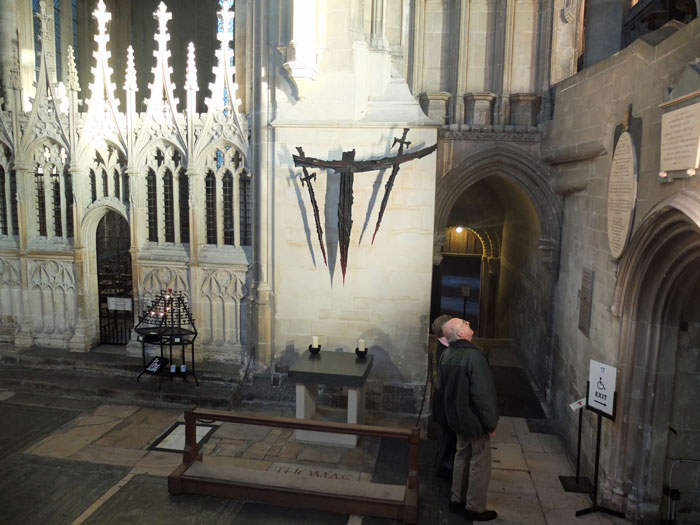The Martyrdom is where Archbishop Thomas Becket was murdered in 1170. A near black stone altar has been placed against the wall of the North West Transept where the medieval Altar Of The Sword’s Point once stood. The Sword Point was the shattered fragment of Richard le Bret’s sword used in the murder of Becket. The altar is said to represent the severity and sacrifice of Christian martyrdom. It is carved from a single stone block, apparently based on a similar altar design to be found in a 13th century window in the Trinity Chapel. The altar stone is a monolithic block of unknown stone. Close inspection is not permissible and there appears to be no written record. There are what appear to be four insets in the centre of the altar’s upper face. While the altar itself is polished these insets simply reflect a different surface finish of the same stone, perhaps bush hammered. If anyone has knowledge of the stone used for the altar we would be pleased to hear from you – click here to contact us.
Suspended above the altar is a modern jagged cross made from wrought iron or bronze – sources differ. This alludes to the sacrifice of the martyrdom. Hanging from the cross are two red-pointed swords with respective shadows giving an image of the four swords brought into the church by the four knights that had a hand in Becket’s death. To enhance the shadow-effect the Caen Stone wall behind the altar has been heavily limewashed.
The sculpture was designed by Giles Blomfield of Truro and paid for by the Friends of Canterbury Cathedral. It was completed during the first quarter of 1986, following which it was dedicated by Archbishop Robert Runcie.
Set into the pavement in front of the memorial in 1985 is a tablet with the name THOMAS inscribed in red lettering. It was designed by David Kindersley who was once an apprentice of the type face designer Eric Gill. The stone used is a fossiliferous limestone.

